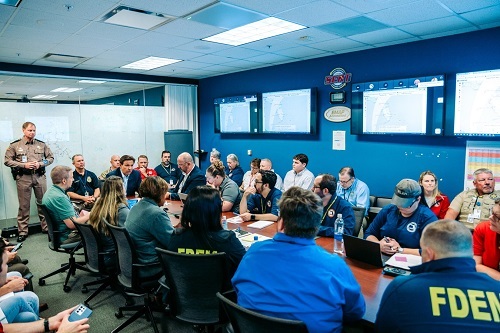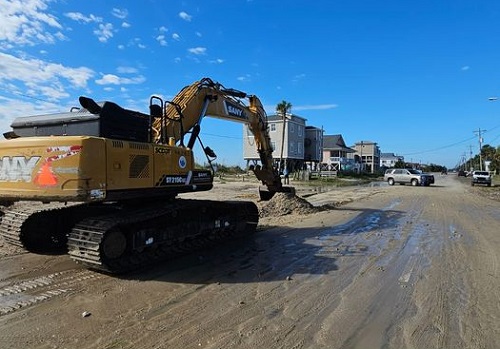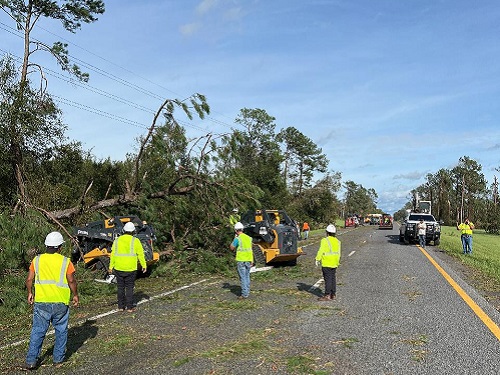The Florida Department of Transportation and other state departments of transportation in the southeast are working to help the region recover from the impact of Hurricane Idalia.
[Above photo by the Florida DOT]
The storm came ashore north of the Tampa Bay region of Florida on August 29 as a Category 3 hurricane, making it the strongest to make landfall in the Big Bend region in more than 125 years. It tracked across northern Florida, Georgia, and the Carolinas, generating high winds and heavy rains, which caused major flooding in many parts of those states.
A preliminary estimate from AccuWeather of Hurricane Idalia’s total damage and economic loss in the southeast U.S. ranges between $18 billion to $20 billion. That compares to the roughly $210 billion in damage caused by Hurricane Ian in 2022, according to the weather outlet.

Florida Governor Ron DeSantis (R) said in a statement that as of August 30 all state bridges in areas impacted by Hurricane Idalia have been cleared by the Florida DOT, including Cedar Key Bridge – an “important step” in the recovery process and will allow first responders, law enforcement, utility linemen, and supplies to move into areas hard-hit by the storm.
President Biden also approved Florida’s request for a major disaster declaration for Hurricane Idalia, allowing for the reimbursement of debris removal and authorizing individual assistance for those impacted by the storm in seven counties across the state.
The Florida DOT has nearly 700 team members deployed to the impacted areas, which includes nearly 100 bridge inspectors and 224 debris removal teams, known as “Cut and Toss” crews. Those crew members have cleared 6,600 miles of roadway so far.
The Florida DOT has also deployed nearly 250 pieces of major equipment – including 140 dump trucks, 59 pumps, and more than 200 pieces of other heavy equipment, such as front-end loaders, skid-steers, etc. – to help remove debris and begin the reconstruction process. That includes nearly 1,100 generators deployed by the agency to help restore traffic signals.

In Georgia, Governor Brian Kemp (R) issued a State of Emergency order on August 29 to prepare for the impact of Idalia’s projected four to eight inches of rainfall and 60 to 80 mile per hour wind gusts, with areas of South Georgia projected to take the brunt of the storm.
The Georgia Department of Transportation put nearly 1,200 employees statewide on “stand-by” to respond to storm impacts, along with over 1,100 pieces of vital equipment and vehicles to support those hurricane response efforts. The agency noted on August 31 that coastal bridges closed as a precautionary measure ahead of storm have returned to normal traffic operation after extensive inspection.
Meanwhile, the South Carolina Department of Transportation began prepping its work crews ahead Idalia’s landfall earlier in the week by loading trucks, sharpening blades, and cleaning out storm drains among other tasks.
“There are no dress rehearsals for safety and preparedness,” said South Carolina DOT Secretary Christy Hall in a statement.

“Once we started tracking this storm, our maintenance forces began locating potential trouble areas that could be affected by strong winds, prepping equipment and establishing a plan to keep South Carolinians safe,” she added. “[We] worked hard ahead of the storm to prepare and we stand ready to respond to any impacts.”
Concurrently, the North Carolina Department of Transportation suspended its ferry service for August 31 in preparation for the remains of Idalia affecting the conditions of the state’s waterways.
NCDOT put 2,200 employees on stand-by for storm response, along with 1,900 trucks, backhoes, loaders and motor graders ready to clear debris, as needed, after the storm passes. NCDOT crews also worked to get ahead of flooding by checking catch basins and culvert inlets statewide for obstructions at known trouble spots.
The department also noted it is using its new award-winning flood warning system – formally activated in May 2022 – in ways it never has before to prepare for and respond to Hurricane Idalia. The agency said its new flood warning system has new storm surge prediction capabilities that enable staff to make more informed decisions to help protect the traveling public.
NCDOT said it is also using drones to conduct pre-storm flights to high-risk coastal areas to gather imagery that will help with post-hurricane damage assessments. The drone teams can also quickly mobilize to respond to requests for flights to assess damage, monitor flooding, inform traffic routing, and livestream video for situational awareness.
 Top Stories
Top Stories
USDOT Issues $1B in Local Road Safety Funding
January 2, 2026 Top Stories
Top Stories

